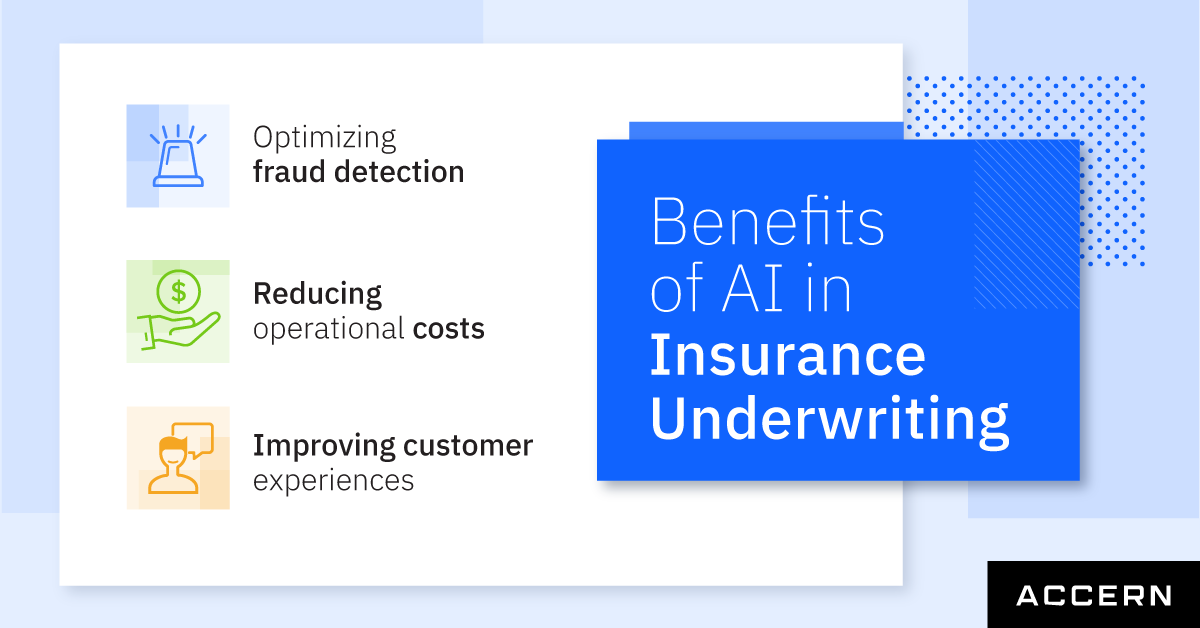How AI is Transforming the Insurance Underwriting Process

The insurance industry is a $1.2 trillion industry in the U.S. alone. Just as with most industries nowadays, the insurance sector is being transformed by the continued digitization of the financial world. With strict regulations, the resources required to manage risk, and the time needed to build trust with consumers, the industry has been hesitant to adopt new tools. However, AI in insurance underwriting is a valuable tool for financial services firms today. Not only can machine learning and AI algorithms help companies better optimize risk management and fraud detection, but they also can improve the customer experience and reduce operational costs.
Essentially built around pricing risk levels, the concept of insurance has been around for centuries. While not immune to the macro-level shifts the finance sector has faced in the past, it has typically insulated itself from adapting to the latest technologies. AI in insurance underwriting is only the latest development in the industry. Still, it is a modern solution to the challenges insurers face today, resulting in an overall net benefit for insurers and consumers.
Challenges facing insurance underwriting
Underwriting is a manual-intensive process for underwriters, whether in commercial or retail insurance. Underwriters are overwhelmed with piles of physical and digital paperwork and must go through applications multiple times to ensure completion. As consumer data expands and technology advances, the core functions of the insurance industry have gotten increasingly complex, especially when it comes to risk management and customer retention. The biggest challenges facing insurance underwriting today are the growing data and regulations facing insurance firms today.
Overwhelming amounts of data
Insurers spend approximately one-third of their time finding information required to complete their work. Due to the volume, variety, and complexity of unstructured data, manual data analysis is often repetitive and time-consuming. This makes it even more difficult for insurance companies to remain competitive and preserve their brand reputation in an environment where regulations are constantly changing.
At its core, insurance underwriting relies on a wealth of structured and unstructured data to appropriately price and balance clients' risks. Nowadays, companies need more consumers' data than ever before, and in today's data-rich environment, insurers do not have immediate access to the information necessary to make informed decisions. The challenge, then, is to find a way to properly sift through all the available data and find the points that are relevant to the underwriting process. With how quickly information is made and collected, the volume of data is difficult for a human to process effectively all on their own.
Operating in a highly-regulated industry
Due to the nature of the industry and the volume of claims processed each day, insurance companies are plagued by red tape and bogged down by policies and regulations. Therefore, the industry is typically viewed as slow-moving and outdated. Insurance companies historically haven't been early adopters of the latest technology, and the process of making a claim hasn't changed much in recent decades.
As technology evolves, data will only grow, making it harder for insurers to underwrite policies and make informed decisions. Insurance firms that are quick to adapt to the changing landscape by adopting AI will increase productivity and provide better customer service. According to a report by Accenture, 75 percent of insurance executives believe that AI will transform every aspect of the industry within the next few years.
However, the report also reveals that insurers face challenges integrating traditional AI tools into their current technology. For example, data quality, privacy, and infrastructure compatibility are some challenges that insurance firms face with AI tools. Fortunately, with technological advancements, no-code AI offered through software-as-a-service solutions solves these challenges.
Benefits of using AI in underwriting

The underwriting process is all about data. Since the beginning, insurers have evaluated risk by interpreting data and other factors to make informed decisions. Today, the process is more complex than ever as data expands in various unstructured formats. According to a recent survey, more than 50 percent of insurance executives prioritized innovating the underwriting process, claiming that AI and automation in underwriting will help their companies grow.
AI and automation are well suited to help insurance underwriters quickly navigate massive amounts of data. AI benefits the insurance industry by providing better and more efficient ways to analyze and evaluate data and changing the way underwriters and businesses work for the better. Today, 53 percent of insurance firms use AI in one or more business processes. Still, a study by Accenture estimates that investments in intelligent solutions could result in a $20 billion increase for U.S. insurers.
In the coming years, AI and automation will be implemented across various business processes within the insurance industry. AI will enable insurers to make better data-driven decisions faster with AI-powered text analytics. AI's natural language processing (NLP) capabilities will allow insurers to obtain hidden insights from data sets. Additionally, AI will enable underwriters to automate simple tasks like researching data and extracting insights in real-time. This allows employees to focus on complex tasks, resulting in better customer experiences.
Here are the top ways that AI is transforming the insurance underwriting process:
Optimizing Fraud Detection
One expensive area for insurers has always been fraudulent claims. Hindering the firm's overall profitability, fraud in the insurance industry costs about $40 billion each year. With the help of AI and machine learning algorithms, companies can be better equipped to detect fraudulent claims to be flagged for further review by humans. Without relying on human efforts to spot unusual claims amid the thousands that are filed each day, firms can save time and money when utilizing AI or machine learning for this purpose.
While fraud continues to evolve as scammers find new ways, it affects all types of insurance. Insurance fraud can come in false or stolen identities to obtain a new policy, incorrect payee information, false application details, and more. Claimants who attempt to commit fraud will do so to receive additional insurance benefits or advantages that they are not entitled to. The industries most affected by fraud are automobile insurance, workers' compensation, and health insurance. According to the Coalition of Insurance Fraud, approximately $80 billion is lost annually from all kinds of insurance fraud in the United States alone. Additionally, 5-10 percent of insurance claims costs are made up of fraud in the United States and Canada.
Insurance firms can identify potential fraud with predictive analytics by using data from the claimant's activities. Identifying fraud before it happens makes it much more likely for insurers to prevent possible fraud or pursue corrective measures, saving the firm millions of dollars that can be otherwise lost to fraud. Predictive analytics can even be used on a claimant's social media and online activity to analyze data after a claim is settled for any action that can reveal red flags. Insurers can also detect fraud by using predictive analytics to identify any mismatches between the claimant and any third parties involved in the claim, such as a repair shop, to ensure that payouts for repairs are being used as intended.
Additionally, their risk management capabilities become more sophisticated and accurate with all the extra data that companies can process by using AI in insurance underwriting. This can result in positive benefits for both the insurer and the consumer, including better discounts for customers and less risk exposure for the firm.
Improving customer experiences
Using AI in insurance underwriting provides positive implications for financial services firms and their clients. With new technologies and more advanced marketing, consumers are accustomed to full personalization and customization regardless of the product or service, and insurance is no exception. This demand will only increase as Millenial, and Gen Z generations are less trusting of businesses, care more about data privacy, and demand personalized services. By utilizing AI and machine learning in underwriting, firms can provide customized quotes and relevant coverage solutions much quicker than before.
In addition, AI enables insurance firms to automate many of the manual and repetitive tasks. By training AI models to adapt to specific situations, manual processes within underwriting can be automated. In today's world, where "rapid" is the standard for everything, automation allows insurance firms to have more control while speeding up and streaming the process so that clients receive decisions quicker than before. Automation also will enable underwriters to set their risk limits and price bands. This makes the whole underwriting process much quicker and easier for insurers and consumers as AI helps firms improve their operations without sacrificing the customer experience.
Reducing operational costs
AI in insurance underwriting can have a tangible impact on the bottom line for insurers. Firms can see ROI quicker when using AI because of its ability to hone in on the most critical data points and sort through them faster than humans. The automation capabilities of AI also cut down on the amount of time a human needs to calculate risk and assess a client manually. The time-saving benefits that AI brings to insurance firms enable insurers to focus on the tasks that make the most difference, like ensuring current clients are satisfied and bringing in new customers.
Specifically, no-code AI further enables insurance firms to reduce operational costs as insurers themselves can build out AI models without having the technical expertise required to build and train AI models specific for insurance underwriting. No-code AI enables a quicker adoption of AI and allows insurers to access the benefits of AI without the steep learning curve.
How business leaders can use no-code AI in insurance underwriting
All in all, the impacts that AI and machine learning will have on the insurance industry are just beginning. No-code AI solutions, like Accern, make it so joining the modernized world of insurance doesn't have to be out of reach for insurance firms. Insurers can quickly use AI to extract insights without the added task of coding. As customers increasingly demand more out of their insurance providers, there is no doubt that the firms that can utilize more sophisticated solutions to improve their personalization and ease of service will have the upper hand. No-code AI tools in insurance underwriting are set to revolutionize the industry, and insurers can re-invent how they operate and interact with clients.
Conclusion
Typically viewed as one of the most outdated industries, insurance companies are now adapting to the digital landscape and proving they can be just as agile and modernized as other sectors. As data continues to expand and customers grow more accustomed to highly-personalized and rapid solutions, the insurance sector has no choice but to adapt to the times and embrace change.
Companies are only beginning to see how helpful AI in insurance underwriting can be between better data analysis, fraud detection, and lower operational costs. The financial services industry will continue to evolve as AI becomes more sophisticated, which will result in a quicker, cheaper, and more pleasurable experience for all.
Not sure where to start in your artificial intelligence journey? Reach out to Accern to schedule a demo on how no-code AI can help insurance underwriting.
